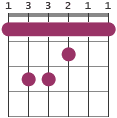The CAGED system
CAGED is an often heard term and refer to the chords C, A, G, E and D, all major. Specifically how these chords are played in open position.
The shapes for these can be used all over the fretboard and based on barre chords. The most common are the E and A shapes in major barre chords. The D shape is also fairly often used while the C and G shapes in barre shapes are not very convenient.

The advantage of CAGED is to use a way to systematize the notes on the fingerboard.
How to use CAGED?
As already mentioned, you can use the shapes of the chords along with a barre (or a capo) and play all possible major chords.
Note that some of these are hard to achieve, since they demand a great stretch. Therefore, the G shape is not very used in this aspect. As mentioned earlier, the most common shapes are the A and E shapes, which are used for standard barre chords.
Examples of CAGED chords
Some examples of chord based on C, A, G, E and D shapes.
G (C shape)
C# (A shape)
B (G shape)
F (E shape)
E (D shape)
Comments
The C shape in front of a 3-string barre on third fret creates a G major.
The A shape in front of a barre on fourth fret creates a C# major.
The G shape in front of a barre on fourth fret creates a B major.
The E shape in front of a barre on first fret creates an F major.
The D shape plus the root note on second fret creates an E major.
A more convenient way to use the C shape is to skip the 1st string; therefore, D major could be played as X5423X instead of X54232.
The C shape can also be played by including the 6th string and create inversions. For example, Emaj7/G# as 476444.
The shape can be simplified by only using the three lowest strings, for example B as 764XXX.
The D shape is more often used for a 7th dominant chord, for example F7 as XX3545.
Minor chords
The CAGED system doesn't end with major chords, it's possible to continue with (almost) the same approach for minor chords. But only almost, since Gm and Cm are not suited for this.




